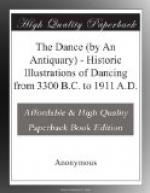[Illustration: Fig. 6.—Phoenician patera, from Idalium, showing a religious ritual dance before a goddess in a temple round a sun emblem.]
When they passed the Red Sea, Miriam and the maidens danced in chorus with singing and the beating of the timbrel (tambour). (Exodus xv. v. 1.)
[Illustration: Fig. 7.—Female figure smelling a lotus. From a painting in the British Museum.]
King David not only danced before the ark (2 Samuel vi. v. 16), but mentions dancing in the 149th and 150th Psalm. Certain historians also tell us that they had dancing in their ritual of the seasons. Their dancing seems to have been associated with joy, as we read of “a time to mourn and a time to dance”; we find (Eccles. iii. v. 4) they had also the pipes: “We have piped to you and you have not danced” (Matthew xi. v. 17). These dances were evidently executed by the peoples themselves, and not by public performers.
[Illustration: Fig. 8.—Dance of Bacchantes, painted by the ceramic painter, Hieron. (British Museum,)]
CHAPTER II.
DANCING WITH THE GREEKS.
With the Greeks, dancing certainly was primarily part of a religious rite; with music it formed the lyric art. The term, however, with them included all those actions of the body and limbs, and all expressions and actions of the features and head which suggest ideas; marching, acrobatic performances, and mimetic action all came into the term.
According to the historians, the Greeks attributed dancing to their deities: Homer makes Apollo orchestes, or the dancer; and amongst the early dances is that in his honour called the Hyporchema. Their dances may be divided into sections somewhat thus: (1) those of a religious species, (2) those of a gymnastic nature, (3) those of a mimetic character, (4) those of the theatre, such as the chorus, (5) those partly social, partly religious dances, such as the hymeneal, and (6) chamber dances.
Grown up men and women did not dance together, but the youth of both sexes joined in the Horm[)o]s or chain dance and the G[)e]r[)a]n[)o]s, or crane (see fig. 11).
[Illustration: Fig. 9.—Dancing Bacchante. From a vase in the British Museum.]
[Illustration: Fig. 10.—Greek terra cotta dancing girl, about 350 B.C. (British Museum.)]
According to some authorities, one of the most primitive of the first class, attributed to Phrygian origin, was the Aloenes, danced to the Phrygian flute by the priests of Cybele in honour of her daughter Ceres. The dances ultimately celebrated in her cult were numerous: such as the Anthema, the Bookolos, the Epicredros, and many others, some rustic for labourers, others of shepherds, etc. Every locality seems to have had a dance of its own. Dances in honour of Venus were common, she was the patroness of proper and decent dancing; on the contrary, those in honour of Dionysius or Bacchus degenerated into revelry and obscenity. The Epilenios danced when the grapes were pressed, and imitated the gathering and pressing. The Anteisterios danced when the wine was vatted (figs. 8, 9, 10), and the Bahilicos, danced to the sistrus, cymbals, and tambour, often degenerated into orgies.




